________________
70
Jaina Community–A Sccial Survey
castes some members of which happen to follow the Jaina religion and as such they form into distinct groups or sub-castes in those
tes. It cannot be definitely said whether these small sections were converted to Jainism or they continued to follow the Jaina religion while the rest of the caste members changed their religion. In any case it appears that these sections are of sufficiently long standing and they have a fixed mode of behaviour with other sections of the same caste. Among the Devāmgas, also known as Hatakaras, Koshtīs or Sālis, there are 33 endogamous divisions of which the 10th is a Jaina division.23 Jaina Guravas, an endogamous division of Guravas, resemble local Brahmins in matters of religion and custom. They abstain from flesh and liquor and do not take food and water from any Hindu caste, even from Brahmins. They are mainly servants in village 'temples which, though dedicated to Brahmanic gods, have still by their sides broken remains of Jaina images. This, and the fact that most of the temple land grants date from a time when Jainism was the state religion, support the theory that the Jaina Guravas are probably Jaina temple servants who have come under the influence partly of Limgāyata religion and partly of Brahmanism. They are found mainly in Malvan Taluka of the Ratnagiri District.24 In the north Gujarātha a few Mālīs are Jainas and form a separate division of Jaina Mālis.25 In the Uttar Pradesh there are Jaina sections among Rajputs and Unai or Unaya caste.26 According to the 1911 census there are more than 125 Hindu and other castes among whom there are Jaina followers.27 Thus we find Agaravālas among Jainas, Hindus, Sikhs, Buddhists and Mussalmans. Moreover some Jaina castes completely merge into Hindus and consider themselves as Hindus. There was a sub-caste of Jaina Kalāras in the former Central Provinces, but they are said to have gone to Hinduism.28 " * Thirdly, as a small Jaina community is divided into more than 100 castes, we find that each caste forms a very small group. Excepting a few castes like Osavāla, Śrīmāla, Agaravāla, Khandelavāla, Saitavāla, Paravāra, Chaturtha, and Pañchama, the rest claim -a meagie strength. Since all these small castes are endogamous, many have necessarily to remain unmarried and as such their population is fastly declining. There are nearly sixty castes whose population is less than one hundred. There are seventeen castes which are on the way of being wiped out. The population of




